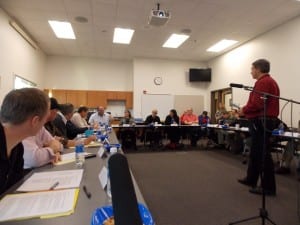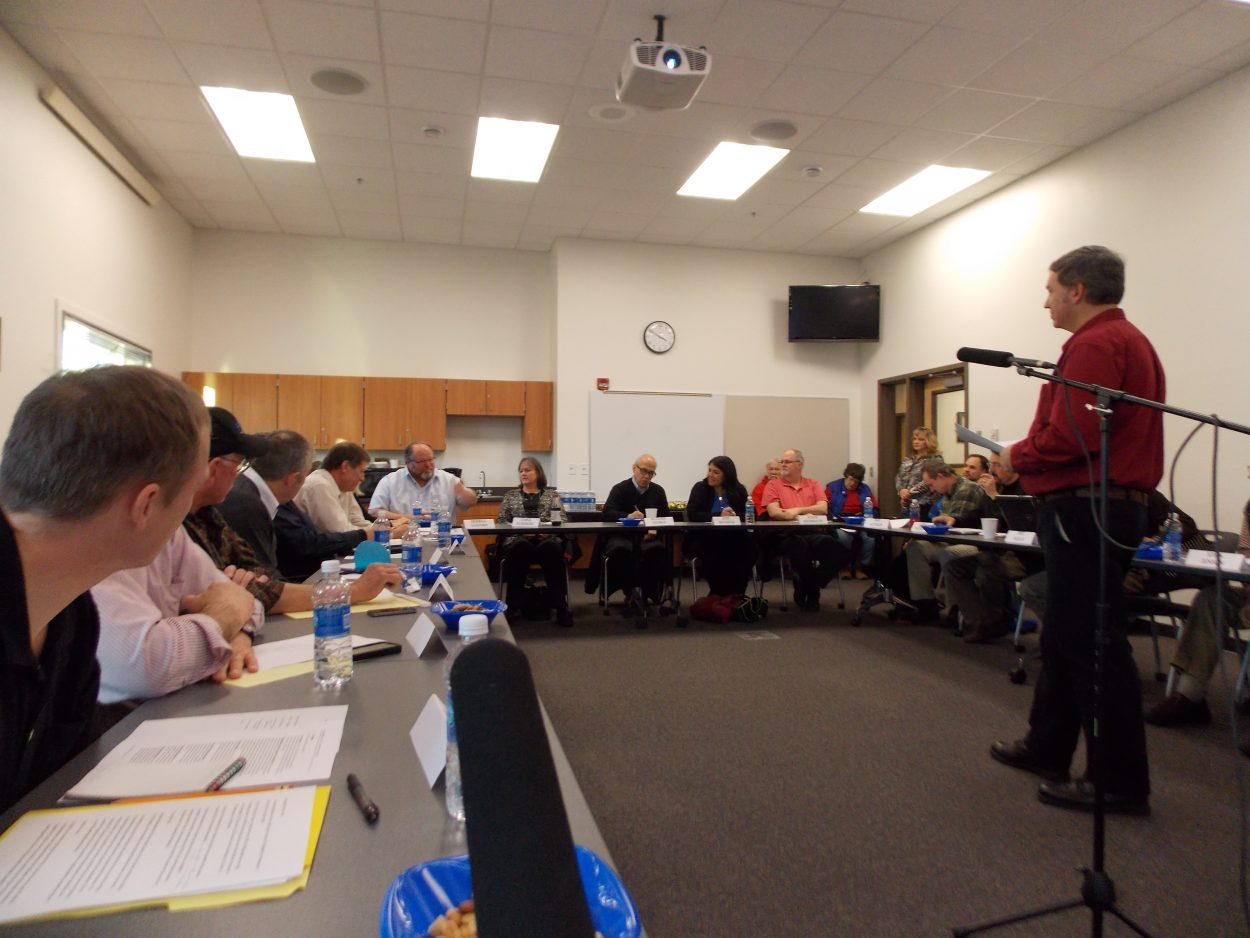Southeast leaders and electric utility managers want to increase regional collaboration on the development of new hydro-power facilities and other energy sources. Many of them met last week for an energy summit of sorts in Petersburg. In part one of a two part story, Matt Lichtenstein reports on some of their communities’ needs and the challenges they face.
For mobile-friendly audio, click here.

Southeast Conference Energy Coordinator Robert Venables moderates a discussion of regional energy issues in Petersburg.
Getting off expensive diesel power or at least reducing the need for diesel, was the most common goal for everyone in the room. While the larger communities are already powered by cheaper and cleaner hydro-electric plants, a number of towns are relying on an increasing amount of diesel to meet a growing demand. Several of the smaller communities are completely dependent on diesel plants.
The group of about 30 local, regional, state and federal officials met for a three-hour roundtable at Petersburg’s firehall, where facilitator was Robert Venables laid out several questions:
“What is occurring in our communities? What loads do we see happening and what continuing analysis of resources is on the forefront to happen.?”
Venables is the energy coordinator for the Southeast Conference, a regional advocacy group for businesses and communities, many of which were represented in the room. Venables reviewed some of the key findings from a recent, state-sponsored planning effort on southeast energy. One universal problem is the region’s inability to store up energy to meet peak demands in the wintertime:
“We kind of characterize Southeast Alaska as a Saudi Arabia of hydro-electric resources. Well in the summer time that’s true. We have seepage and leakage and everything occurring, water left and right but the sustaining storage capacity doesn’t exist in our hydro-electric system and how does that get developed because that’s where the real value is.”
Many at the table emphasized the need for more generation and called for regional cooperation on the development of a large hydro project and accompanying lines that could help power a substantial part of the panhandle.
Federal regulators ended a private bid to build a hydro plant at Thomas Bay near Petersburg last year after ruling that the Bellingham-based company did not pursue development of its license application in good faith and with due diligence.
Petersburg had opposed that company’s plans. Mayor Mark Jensen suggested Southeast municipalities work together for hydro development at Thomas Bay.
“We need to get more generation coming from some direction. If we got it from Thomas Bay, it could be tied right into the grid and potentially there could even be, and this is a pretty big plan, but a line that would go up and tie into Snettisham. If that ever came into fruition we’d be tied in from Greens Creek all the way to Metlakatla.”
Snettisham is the major hydro plant that powers Juneau, which is served by the privately-owned Alaska Electric Light and Power Company. Municipal-owned utilities supply electricity to much of Southeast. That includes Petersburg, Wrangell and Ketchikan which govern the Southeast Alaska Power Agency. SEAPA owns the two large hydro plants and connecting transmission lines that power those towns with some of the lowest rates in the state.
Rather than building another big plant, Wrangell’s recently-retired Mayor Don McConachie suggested lots of smaller ones could be brought online sooner:
“It just kind of makes sense to me. We all know that we have a lot of rain. We all know that if we had a series of smaller hydro-electric projects, we could, through interties and water management, could make a very good grid that would be sustainable and you could just forget about diesel generation.”
Like Wrangell and Petersburg, Ketchikan is projecting a significant increase in the amount of diesel it’s going to have to burn to meet the growing demand over the next decade unless another significant source of hydro-power is brought online. Dry weather has only made that worse in Ketchikan, which is planning for a new, but small hydro project at nearby Whitman lake. SEAPA is also looking at raising the damn at its swan lake plant to generate more power. Even with both improvements online, Ketchikan officials expect they will still have to burn a lot of diesel in the years to come.
So, the idea of collaborating on a bigger, regional project appealed to City of Ketchikan Vice Mayor Bob Sivertson:
“There’s a lot of things that we have to work out as communities. We have to get back on track and start working towards that common goal. We all understand we need another hydro project to get off the diesel.”
Juneau Mayor Merril Sanford said the capital city was in the same boat:
“Seems to me that we all are beginning to bump up the upper end of our hydro capacities and we’re all looking at ways to try to overcome that.”
The situation has long been much more severe for the communities in Southeast that are entirely dependent on diesel; Communities like Angoon, Hoonah and Kake which continue to struggle with the high cost of electricity.
The village Native Corporation for Angoon, Kootznoowoo, has been working to develop a small hydro plant at Thayer lake to offset the towns diesel use. Governor Sean Parnell approved seven million dollars for the project in last year’s budget. Angoon Mayor Richard George pointed out that Thayer Lake has been discussed for decades. He worried whether there would be enough funding to finally get it built:
“We’ve got a group of people back home that are waiting for this to happen and this group of people are very concerned, from the state’s posture, that their funding is being depleted. So, its been an upward struggle.”
Angoon has dropped efforts to pursue a large for-profit hydro-development at Thomas Bay, 70 miles to the South near Petersburg. The community had been at odds over that initiative.
George said he was mainly at the meeting to encourage support for the proposed electrical intertie from Petersburg to Kake.
Kake is one of several smaller towns that gets diesel power from the Inside Passage Electric Cooperative. The non-profit is working on a number of projects offset the need for diesel. IPEC General Manager Jodi Mitchell said the more she heard about the growing load in communities that are already served by hydro, the more worried she was there would not be enough surplus for Kake. She encouraged the group to pursue a large hydro project:
“So that we can have some security about power and that the people of kake aren’t disappointed that when the intertie comes in they will actually be getting power from it.”
A contractor for the US Forest Service is preparing a draft environmental Impact Statement for the Kake-Petersburg intertie. The document is expected to come out sometime this spring.
In part two of this story, we’ll hear about a new Southeast Power Agency effort to bring more power into the grid that now serves Petersburg, Wrangell, and Ketchikan.










